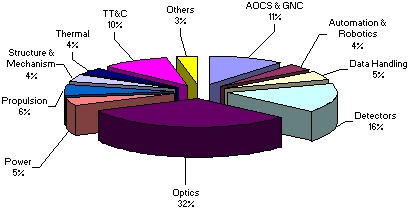SCI-AT: Advanced Payload Technologies
At the same time, the scientific demands are increasing. The key to maintaining high performance with lower cost payloads is in the adoption of smart and innovative technologies. Strategic planning is required for long-term developments.
The activities of the unit are:
- Current technical developments, including cryogenic spectroscopic detectors, compound semiconductors, filters and lightweight optics.
- Advanced technologies focussing on the identification of long-term technology drivers, involving external institutes and industry.
- Strategic developments focussing on future science payload technology requirements.
The ESA Science Technology Development Route
Instruments and spacecraft sub-systems are classified according to a "Technology Readiness level" (TRL) scale 1-10. Levels 1 to 3 relate to creative innovate technologies pre or during mission assessment phase. Levels 4 to 10 relate to existing technologies and to missions in definition phase.
If the TRL is too low, then a mission has a risk to be jeopardized by delays or cost over-runs. Therefore it is of our concern to promote the technology readiness at a very early stage to make new missions feasible.
The Science Programme has different avenues of funding:
- Technology Research Programme (TRP) for innovative technology which is applicable to TRL levels 1 to 4
- Core Technology Programme (CTP) for mission specific developments and is mainly for TRL 4 to 10
- GSTP – General Studies Technology Programme, that is reserved for particular interests of member states which is mainly for TRLs 3 to 10
 |
|
Investment per Technology Domain |
The Satellite technology investments are spread over a wide range of applications. Investments have to be made for instrument technologies as well as general spacecraft sub-systems.
